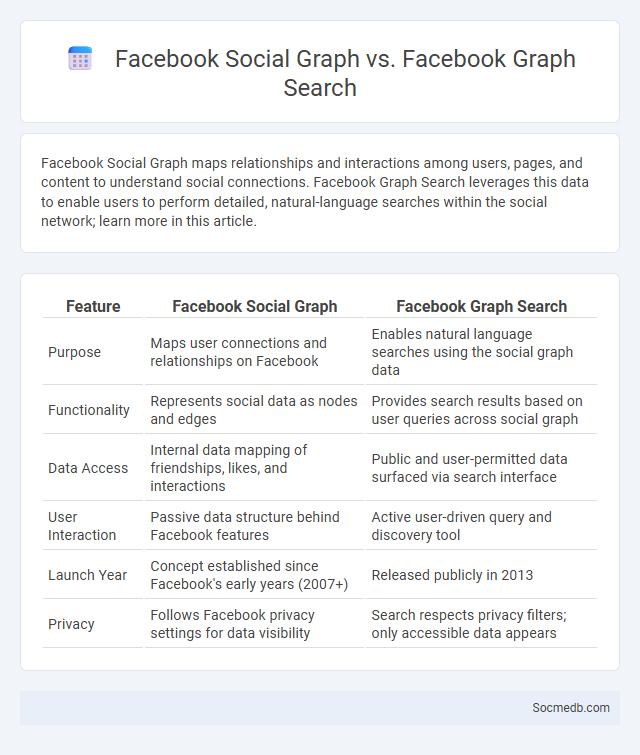
Photo illustration: Facebook Social Graph vs Facebook Graph Search
Facebook Social Graph maps relationships and interactions among users, pages, and content to understand social connections. Facebook Graph Search leverages this data to enable users to perform detailed, natural-language searches within the social network; learn more in this article.
Table of Comparison
| Feature | Facebook Social Graph | Facebook Graph Search |
|---|---|---|
| Purpose | Maps user connections and relationships on Facebook | Enables natural language searches using the social graph data |
| Functionality | Represents social data as nodes and edges | Provides search results based on user queries across social graph |
| Data Access | Internal data mapping of friendships, likes, and interactions | Public and user-permitted data surfaced via search interface |
| User Interaction | Passive data structure behind Facebook features | Active user-driven query and discovery tool |
| Launch Year | Concept established since Facebook's early years (2007+) | Released publicly in 2013 |
| Privacy | Follows Facebook privacy settings for data visibility | Search respects privacy filters; only accessible data appears |
Introduction to Facebook’s Social Graph
Facebook's Social Graph maps the complex web of relationships between users, pages, events, and interests, creating a dynamic network of interconnected data. It enables personalized content delivery and precise ad targeting by analyzing your interactions and connections across the platform. Understanding this graph helps optimize social media strategies and enhances user engagement through relevant recommendations.
Understanding Facebook Graph Search
Facebook Graph Search allows you to explore vast amounts of social data by using natural language queries to find people, places, photos, and interests connected to your network. It leverages metadata and user-generated content, enabling precise discovery based on relationships, locations, and preferences. Mastering Graph Search enhances your ability to target audiences, gather insights, and optimize social media strategies effectively.
Defining the General Social Graph
The general social graph represents the complex network of interconnected individuals, organizations, and digital entities on social media platforms, illustrating relationships and interactions. Understanding your position within this graph is crucial for effectively targeting, engaging, and expanding your online influence. Insights derived from analyzing the general social graph enable personalized content delivery and optimized social media strategies.
Key Features of Facebook Social Graph
The Facebook Social Graph maps your connections, enabling seamless interaction with friends, family, and interests. It integrates vast data points such as profiles, posts, likes, and relationships to deliver personalized content and enhance user engagement. This dynamic network structure supports targeted advertising and community building by analyzing user behavior and social connections.
How Facebook Graph Search Works
Facebook Graph Search operates by indexing billions of connections and interactions between users, including likes, comments, shares, and profile information to deliver personalized search results. It uses natural language processing to interpret queries and semantic mapping to connect entities such as people, places, and interests, enabling highly specific searches like "friends who live in New York and like hiking." This search engine leverages Facebook's vast social graph and privacy settings to provide relevant content while respecting user data permissions.
Social Graph: Broader Social Networking Implications
The Social Graph represents the interconnected relationships between users on social media platforms, mapping friendships, followers, and interactions to create a complex web of digital connections. Understanding the Social Graph enables businesses to enhance targeted advertising, improve content personalization, and foster community engagement by analyzing network patterns and user influence. Social Graph analysis also drives algorithmic recommendations, helps identify key influencers, and supports social marketing strategies that leverage network effects to maximize reach and impact.
Differences Between Facebook Social Graph and General Social Graph
The Facebook Social Graph specifically maps connections and interactions within Facebook's ecosystem, emphasizing user profiles, friendships, likes, and shared content. In contrast, the General Social Graph represents social relationships across multiple platforms and real-world interactions, offering a broader, decentralized view of social connections. Your understanding of these differences helps tailor strategies for targeted engagement and data analysis on each platform.
Comparing Facebook Social Graph and Facebook Graph Search
Facebook Social Graph represents the comprehensive network of connections between users, their interests, and interactions, forming the foundation of personalized content and recommendations. Facebook Graph Search, on the other hand, is a powerful semantic search tool that leverages this social graph to deliver tailored search results based on your friends' activities, likes, and connections. Understanding these distinct yet interconnected features enhances your ability to navigate and utilize Facebook's data-driven platform effectively.
Use Cases and Applications of Social Graph Technologies
Social graph technologies power personalized content recommendations and targeted advertising by mapping relationships between users, enabling brands to reach your ideal audience efficiently. Businesses harness these insights for influencer identification, community detection, and customer sentiment analysis, driving impactful marketing strategies. Social graphs also support social networking platforms in enhancing user engagement through friend suggestions and event recommendations tailored to user interactions.
Future Trends in Social Graph and Graph Search Technologies
Advancements in social graph and graph search technologies are driving personalized user experiences by leveraging complex relationship mapping and real-time data analysis. Future trends emphasize enhanced artificial intelligence integration, enabling more accurate context understanding and predictive connections within social networks. These innovations facilitate deeper insights into user behavior, improving content relevance and targeted social interactions across platforms.
 socmedb.com
socmedb.com